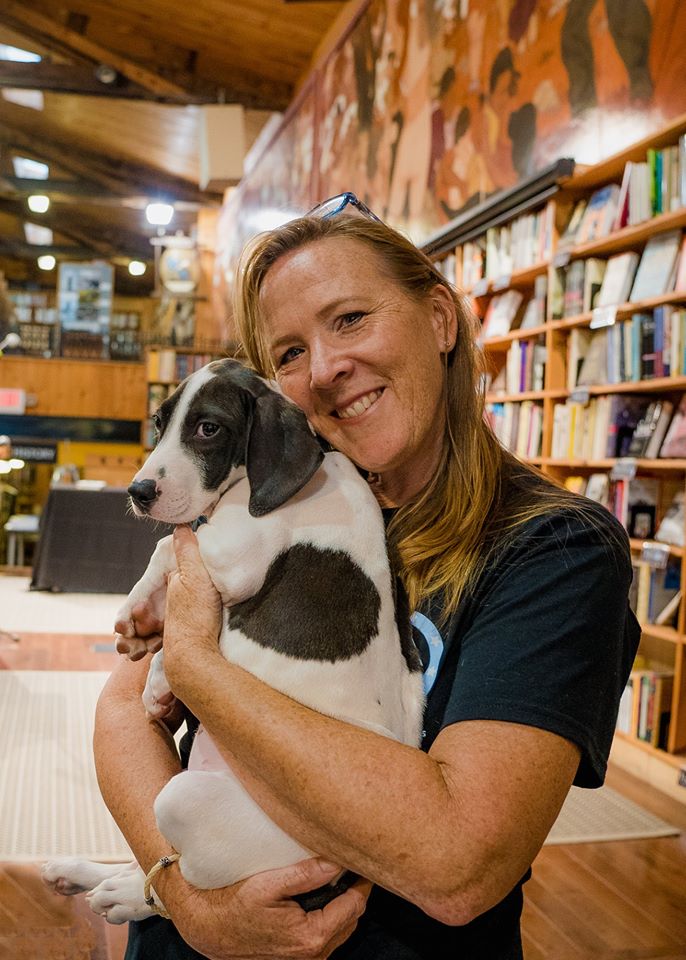Huntington Cabell Wayne Animal Control shelter in Huntington, West Virginia serves the residents of Huntington City and Cabell and Wayne Counties, about 100,000 people. We are big fans of municipalities that join together to pool resources and create a quality shelter like HCWAC. It’s smart sheltering.
The shelter began in 1979 and functioned like a traditional rural shelter/dog pound, killing as many as 50-75 percent of the animals until 2018 when a new director changed their story. Courtney had been an educator for 30 years, and active in rescue for the last ten of those years. She served on the Mayor’s advisory council. She knew there were better ways to run the shelter; she knew they could save more animals.


HCWAS handles about 4000 dogs and cats a year. When we visited there were about 120 dogs and 100 cats in residence. The shelter employs fifteen people, including 2 full-time and 1 part-time Animal Control officer. The employees we met clearly enjoyed their work and the atmosphere at the shelter was bright, friendly, and efficient.
That positive vibe definitely affected the animals, but what really made the difference is Courtney’s commitment to getting every dog’s ‘feet on the grass’ every day. There are three large play yards, and the staff is trained in Dogs Playing for Life.







While playgroups significantly reduce the stress on the animals, the shelter has many smart practices that decrease the stress on the dogs – spacious runs, plenty of outside time, lots of volunteers walking dogs, treats in a bucket outside the kennels for staff and visitors to hand out to any dog with ‘four on the floor’, and intentional housing arrangements placing dogs in the kennels where they can be most comfortable. The shelter is older and the many kennels have been modified and added over the years, creating a hodgepodge of accommodations.









Until this past spring, the shelter sent a transport van (donated by the Stanton Foundation) north every weekend loaded with dogs and cats headed for rescues. Since then, it has dwindled as they experience what everyone else is experiencing – rescues that are full or worn out and not pulling animals. The shelter is crammed with dogs, even utilizing crates on the floor to keep from euthanizing dogs. Despite their current struggles, their save rate remains 98%!
HCWAS is blessed with an incredibly supportive community. The three municipalities contribute about $400,000 of their operating budget, but it takes one million to run the shelter, so the difference must be made up in fundraising and grants.
All animals are vaccinated (dhpp and Bordetella), dewormed and treated for fleas on intake. Courtney tries to get puppies out immediately, knowing the danger of parvo in a shelter. When we visited, they had an adorable litter of puppies secluded in the ‘puppy closet’ and take every precaution in handling them to keep them safe.



There are two vets who volunteer at the shelter once a week doing rabies, testing, and health certificates, but much of their veterinary work is handled by the Community College’s vet tech program. The shelter transports the animals to the college weekly for vet work. The program can do some spay/neuter surgeries, but the shelter relies on local vets for the rest and, like everyone these days, struggles to get appointments.
Soon, though, the college vet program will come to them. The city recently donated the building across the street from the shelter. Courtney walked us through it and told us about their plans to turn the sturdy but old building (which was last used to house the city’s mounted patrol horses!) into classrooms for the college vet-tech program, a medical intake center, and spay/neuter clinic. The Stanton Foundation is donating a mobile spay/neuter clinic which will be permanently parked beside the building, and Courtney is already lining up vets.





About 60% of the animals get out through rescue, but the shelter does adopt out lots of animals, screening them carefully and following up. Courtney talked about the challenge of balancing the two. She wants to have quality animals available for her community, but also not let down rescues who depend on her to send them healthy, adoptable animals too. That’s a challenge that can create conflicts.
While in the area, we heard about a shelter in a nearby county that would rather adopt out locally, instead of sending dogs out through rescue. That has led to a full shelter closed to intake, which to my mind sends us backward in our efforts to save animals. It results in a full shelter which means when owners or good Samaritans want to surrender animals, they are turned away. If private rescues are not available, people are forced into desperate measures.
More and more I’m convinced it’s the relationship with the community that makes a shelter succeed or fail. Clearly, in the Huntington, Cabell, Wayne area that partnership is strong. The shelter was bustling with volunteers, employees, and officers coming and going. It was exciting to see a shelter smack dab in what is often assumed to be an impoverished, dangerous state for dogs, that is a shining example of how good a shelter can be despite the obstacles.
If you’re a shelter or rescue looking for a shelter to partner with, consider HCWAS; they are actively looking for rescue partners. We met so many beautiful, happy, friendly dogs of every shape and size (as you can see in the pictures).










It was inspiring to see, once again, the difference leadership can make. Huntington is not an affluent area; we didn’t see posh neighborhoods or even any real industry. And clearly, there are way too many unwanted animals. The city has breed specific legislation. The building is old with limited space. So many obstacles, and yet, the Huntington Cabell Wayne Animal Shelter is a first-class facility saving every adoptable animal. It can be done, there are plenty of solutions. What we need are more people willing to seek them out.
If you’d like to support the work of Huntington Cabell Wayne Animal Shelter follow their Facebook or shop their Amazon Wishlist, or make a donation through their website.

Until each one has a home,
Cara
If you want to learn more, be sure to subscribe to this blog. And help us spread the word by sharing this post with others. Visit our website to learn more.
You can also help raise awareness by following/commenting/sharing us on Facebook, Instagram, YouTube, and Tik Tok!
We are selling 2023 Who Will Let the Dogs Out calendars to shine a light on some of the beautiful dogs we met this year on our tours (including one from Huntington-Cabell-Wayne Animal Shelter). To order yours, email us: info@whowillletthedogsout.org. Calendars are $25 (shipping is free). We have a limited to supply, so order soon. All proceeds go towards helping more dogs!
Learn more about what is happening in our southern shelters and rescues in the book, One Hundred Dogs & Counting: One Woman, Ten Thousand Miles, and a Journey Into the Heart of Shelters and Rescues (Pegasus Books, 2020). It’s the story of a challenging foster dog who inspired me to travel south to find out where all the dogs were coming from. It tells the story of how Who Will Let the Dogs Out began. Find it anywhere books are sold. A portion of the proceeds of every book sold go to help unwanted animals in the south.

Watch our Emmy-nominated, award-winning short documentary about rescue in western Tennessee here.
For more information on any of our projects, to talk about rescue in your neck of the woods, or become a WWLDO volunteer, please email whowillletthedogsout@gmail.com or carasueachterberg@gmail.com.
And for links to everything WWLDO check out our Linktree.



Leave a Comment
Sign up for our newsletter
Sign up to have our latest news, grant updates, shelter visits, and more delivered to your inbox.
Share this:
Like this: